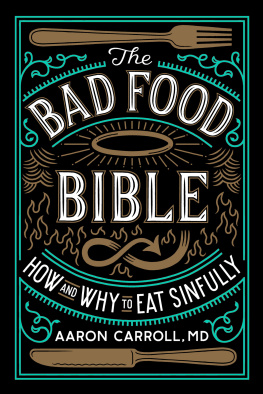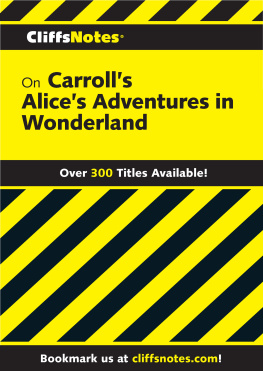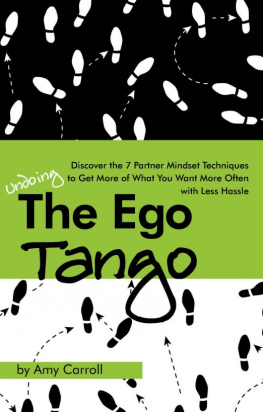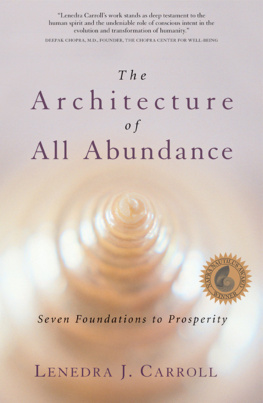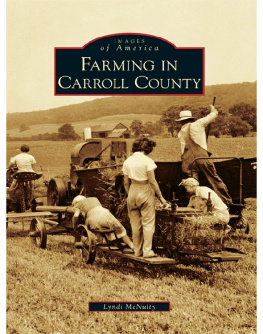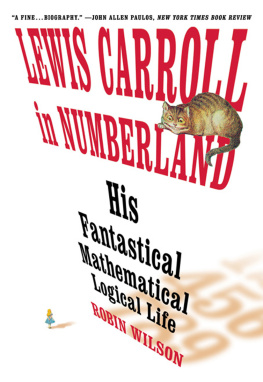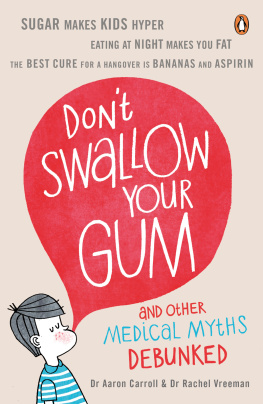Copyright 2017 by Aaron Carroll
Foreword copyright 2017 by Nina Teicholz
Illustrations Jim Tierney
All rights reserved
For information about permission to reproduce selections from this book, write to or to Permissions, Houghton Mifflin Harcourt Publishing Company, 3 Park Avenue, 19th Floor, New York, New York 10016.
hmhco.com
Library of Congress Cataloging-in-Publication Data is available.
ISBN 978-0-544-95256-0
Cover design by Jim Tierney
e ISBN 978-0-544-95257-7
v1.1017
Portions of this book appeared, in different form, in the New York Times.
This book presents the ideas and opinions of its author. It is not intended to be a substitute for consultation with a professional health care practitioner. Readers should consult with their health care practitioner before adopting any of the dietary suggestions contained in this book. The publisher and the author disclaim responsibility for any adverse effects resulting directly or indirectly from information contained in this book.
For Aimee,
because she doesnt get nearly enough credit.
She also makes everything in my life bettereven what I eat.
Foreword
W E live in hard times for people who simply want to eatnormally, that is, in a way that would be recognizable to our ancestors, aiming for no more than a tasty meal, eaten to satisfaction, with a feeling of pleasure. Now, instead, we sit down to dinner in trepidation, our heads swirling with a chorus of wasps whispering, Eat only good foods;beware the bad. This moral freight has weighed so heavily on our food choices that one would expect insurrection to be just around the corner. And, indeed, here it is: The Bad Food Bible, a satisfying book that challenges the very notion of food morality and frees us up for some seriously delicious, sinful eating.
Dr. Aaron Carroll is no knee-jerk heretic. A thoughtful professor of pediatrics who came to the field of nutrition on a simple quest to learn how better to advise his patients, as well as improve his own diet, he found himself mired in the inevitable, dizzying array of experts with radically different opinions about diet, doused in heavy, judgmental language. We dont need an opinion poll to know that Americans are weary of feeling guilty and confused about their food choices. Carroll feels the same, and in his efforts to drill down to some nutritional terra firma, hes taken a refreshingly rigorous scientific approach.
That is to say, Carroll earns his contrarian views the hard way. Not only does he dig into a great deal of scientific literature, but, more important, he also weighs and prioritizes it. This is a far more rare and valiant feat than you might imagine.
One of the biggest problems in nutrition over the past fifty years has been how all datathe good and bad, the weak and strong, alikehave been stirred into one big, undifferentiated pot. Evidence from so-called observational studies, which can only show associations, has been given equal footing with a more rigorous kind of data, from randomized controlled trials. As Carroll explains, only the latter can demonstrate cause and effect, and only the latter can justifiably be used for population-wide nutrition recommendations. Yet health experts have strayed far from this narrow path.
Like most things, this homogenization of data started off with good intentions. Given the complexities of trying to figure out how a lifetime of dietary and lifestyle habits drive disease or death decades later, nutrition science has long been notoriously difficult. It began in the 1950s. Although the data from this period were poor, the rising tide of cardiovascular deaths over previous decades pressured experts into saying something about a disease-proof diet. So they did, based on premature findingswith the result being that much of the early advice was simply wrong.
As Carroll writes, Scientists and doctors are often guilty of acting without sufficient evidenceof making recommendations without having sufficient facts. Most of the time, theyre trying to do the right thing. But in some cases, their efforts can have the opposite effect.
That, he says, is the dirty little secret of medical science.
Carroll discusses the original, big mistakeson butter, meat, eggs, and saltin the opening chapters of this book. These long-standing, seemingly rock-solid pillars of conventional dietary wisdom have toppled, either partially or completely, in recent years. As of 2015, American health authorities have dropped their caps on dietary cholesterolthe reason we avoided eggs and shellfish for decades. And over the past five years, teams of researchers all over the world have challenged long-held beliefs about whether lower is better regarding salt and whether our avoidance of meat and butter is based on solid evidence. The science on all these points, it turns out, is far from settled.
With fascinating detail, Carroll also tackles more recent disputes over genetically modified organisms (GMOs), organic foods, diet soda, gluten, alcohol, and more. These are all topics on which nutrition science has made substantial advancements, yet old habits remain, with many health experts still sifting hard data indiscriminatingly into soft. Carroll is a warm and engaging guide, with funny stories to share about his own eating habits and those of his family, but when it comes to the science, he takes no prisoners. On each of these contested topics, he weighs the evidence carefully and follows the data, even when they lead to conclusions that are inconvenient or unpopular.
On diet soda, for instance, he writes, I dont think that letting my children drink diet soda once in a while makes me a monster, but apparently some people do. Whats more, people seem to object to the diet even more than to the soda. Yet we know more about the dangers of sugar than artificial sweeteners, he notes, and the occasional diet soda isnt going to kill anyone.
This is just one example of the fearmongering that Carroll chides. This demonization of certain foods is fanned by advocacy groups and experts alike, and leaves ordinary people susceptible to terrible advice about their diets. Food phobias paralyze people, to the point where they literally dont know which supermarket aisle to walk down. This uncertainty turns out to be the perfect culture in which ideology, industry tricks, and commonplace charlatanism flourish, leading to diets of all kinds based less on basic nutrition than on aspirations, passion, and, yes, even the freedom from sin.
Maybe its ironic that Carroll calls his book a food bible when the only preaching hes doing is good old-fashioned science, but his ultimate point is that we should back away from faith-based eating and just eat real foodyou know, the kind that our ancestors would have recognized. Plus, perhaps, the occasional diet soda, if you want. No guilt.
Eating is one of the great joys of life. Dont let people use misinformation or bad science to deprive you of the pleasure of good food, Carroll writes. Amen to that.
NINA TEICHOLZ
Nina Teicholz is an investigative journalist and author of the international and New York Times bestseller The Big Fat Surprise. The Economist named it a top science book of 2014, and it was also named a 2014 Best Book by the Wall Street Journal, Forbes, Mother Jones, and Library Journal. Before taking a deep dive into researching nutrition science, Teicholz was a reporter for NPR and also contributed to many publications, including the Wall Street Journal, the New York Times, the Washington Post, The New Yorker, and the Economist. She attended Yale and Stanford, where she studied biology and majored in American studies. She has a masters degree from Oxford University and served as associate director of the Center on Globalization and Sustainable Development at Columbia University. She lives in New York City.
Next page
